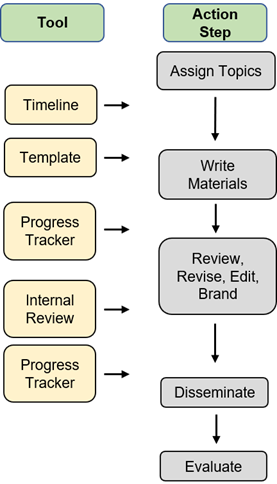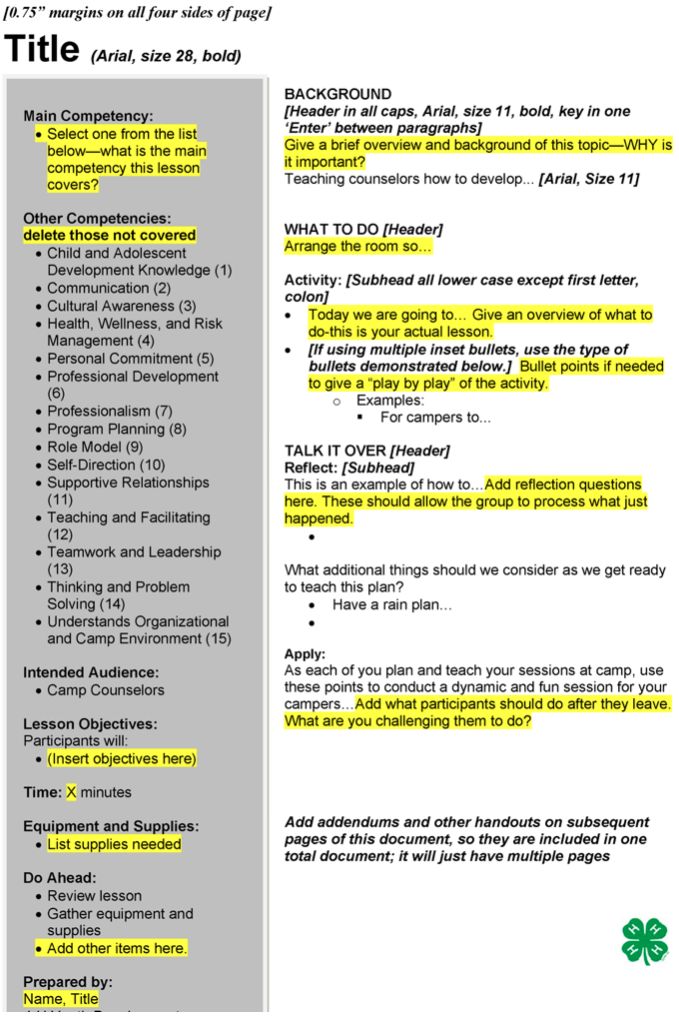 |
October 2019
|
October 2019 // Volume 57 // Number 5 // Tools of the Trade // v57-5tt2
Action Steps and Tools for Managing a Statewide Curriculum Development Process
Abstract
Practical aspects of curriculum development, especially that involving multiple authors, often are overlooked, but they are critical to moving a curriculum from concept to finished product. The Ohio 4-H Camping Design Team developed a competency-model-based curriculum for training the state's 4-H teen camp counselors. The team incorporated action steps and associated management tools to facilitate the curriculum development process. Action steps included establishing a timeline, using a template, tracking progress, and conducting an internal review. The action steps and tools the team used can be replicated by others developing curricula, training programs, and other resources for Extension audiences.
Introduction
Extension professionals are responsible for training individuals serving in a variety of volunteer roles. Having a training curriculum assists those who train these individuals and ensures that participants learn the information necessary to be successful. Developing a curriculum is a complex process that involves translating institution-level goals into documents and materials and preparing subject matter for educational use (Smith et al., 2017).
Literature on curriculum development includes discussions on theoretical grounding of a curriculum, integral elements of curriculum content, and starting points for building a curriculum, among other topics. Smith et al. (2017) proposed application of a curriculum development model. Other authors have noted that intentionally identifying and training individuals on desired skills and behaviors is important for achieving desired outcomes (Galloway, Bourdeau, Arnold, & Nott, 2013; VanWinkle, Busler, Bowman, & Manoogian, 2002). Authors also have suggested that curriculum developers can use focus group research (Benke et al., 2013), surveys (Smith, Meehan, & Dasher, 2009), literature reviews, and identification of societal needs (Smith et al., 2017) to inform curriculum development. Additionally, a competency model can be used as a curriculum development foundation (Byham & Moyer, 2005). Identifying competencies clarifies an individual's effective performance, which has an impact on an organization's or a program's outcomes (McClelland, 1973; Stevens, 2012). Several authors (Brodeur, Higgins, Galindo-Gonzalez, Craig, & Haile, 2011; Epley, Ferrari, & Cochran, 2017) have reiterated the usefulness of a competency model as the starting point for curriculum development.
Obviously, discussions on curriculum development are wide ranging. However, practical aspects of curriculum development are often left out of these discussions. Yet these practical aspects are important for ensuring that a curriculum moves from concept to product, especially when many authors are involved in the development process. Using the experience of having coordinated development of a statewide camp counselor training curriculum and applying information set forth by Smith et al. (2017) as the foundation for the development process, I describe herein action steps and associated management tools that facilitated practical aspects of the work.
Curriculum Development Process
Ohio 4-H has design teams comprising professionals with expertise and knowledge in a particular subject area that are charged with developing curricula, training opportunities, evaluation instruments, and other resources related to their subject areas. Recognizing the important role camp counselors play in conducting quality youth programs, the Camping Design Team identified a need to develop a statewide camp counselor training curriculum, and I served as coordinator during the development process.
We used an existing competency model for teen camp counselors (Epley, 2014) as a starting point. When an organization uses its own competency model to develop a curriculum, the model is more easily customized to the organization's needs (Rothwell & Lindholm, 1999).
The curriculum needed to meet several practical considerations. It needed to
- be usable with different group sizes and in varied training formats, settings, and time periods;
- be cost effective;
- incorporate experiential learning model use;
- appeal to new and experienced professionals; and
- engage new and experienced learners.
Curriculum Development Action Steps
After soliciting experts who would develop the curriculum and identifying topics to include, we took these action steps:
- Assign topics. On the basis of their interests and expertise, Camping Design Team members self-selected one or more topics from the comprehensive list.
- Write lesson plans, resources, and other curriculum content. Individuals gathered data and wrote draft lesson plans, supplemental information, and other resources related to their identified topics.
- Review, revise, edit, and brand. I packaged all items to undergo the state's blind peer review process. After receiving reviewers' feedback, the original authors edited their documents as needed. In accordance with an overarching recommendation, an editor reviewed the entire curriculum package to ensure one voice throughout all pieces in the curriculum. In compliance with university guidelines, appropriate college branding and graphics were added.
- Disseminate. We disseminated the curriculum at a statewide training. When individuals have an opportunity to experience curriculum components prior to teaching, anxiety decreases and confidence increases (Konen & Horton, 2000).
- Evaluate. Curriculum users received a questionnaire after a year of use. They were asked to indicate the curriculum's most useful components, their plans for future use of the curriculum, and whether they would recommend the curriculum to others. They also identified elements to add to the curriculum. This feedback helped the Camping Design Team members understand the curriculum's effectiveness and how to improve it.
I created several tools to manage the process more efficiently. Figure 1 depicts the tools in relation to the action steps, and the tools are described in the next section.
Figure 1.
Tool Use in Relation to Action Steps

Curriculum Development Management Tools
- Timeline. I created a timeline to assist individuals with managing their job duties throughout the process. The timeline included deadlines for document creation, internal and external peer review, and curriculum dissemination.
- Template. For consistency, I developed a template for team members to use when writing lesson plans and other curriculum components. The template included an overview of lesson information, such as the competencies covered, intended audience, objectives, time required, equipment and supplies needed, and actions to take prior to instruction. In addition, the template included headings for sections on background on the topic, activity instructions, reflection, and application. Figure 2 shows the template layout.
Figure 2.
Lesson Plan Template

- Progress tracker. Team members submitted their drafts to me. I sent deadline reminders and tracked necessary information, including
- topic area,
- author,
- item title,
- draft completion date,
- peer review assignment,
- peer review completion date, and
- final completion date.
- Internal peer review. For each item, I assigned another Camping Design Team member as a peer reviewer. I asked reviewers to assess readability, content, and utility (Coleman, Byrd-Bredbenner, Baker, & Bowen, 2011). We did not assess the evaluation component because there was an overall evaluation piece for the curriculum. Team members submitted their reviews, and I provided the original authors with suggested revisions. This review took place prior to the external review to strengthen the quality of the curriculum. The original authors revised items according to suggested edits and returned the final documents to me.
Conclusion
The action steps and management tools highlighted herein are useful during the curriculum development process. Extension professionals can apply them when developing curricula and training programs for audiences such as master gardeners, master naturalists, 4-H club volunteers, and camp directors.
References
Benke, C. J., Bailey, S. J., Martz, J., Paul, L., Lynch, W., & Eldridge, G. (2013). Developing a parent-centered obesity prevention program for 4-H families: Implications for Extension family programming. Journal of Extension, 51(3), Article 3FEA8. Available at: https://joe.org/joe/2013june/a8.php
Brodeur, C. W., Higgins, C., Galindo-Gonzalez, S., Craig, D. D., & Haile, T. (2011). Designing at competency-based new county Extension personnel training program: A novel approach. Journal of Extension, 49(3), Article 3FEA2. Available at: https://www.joe.org/joe/2011june/a2.php
Byham, W. C., & Moyer, R. P. (2005). Using competencies to build a successful organization [Monograph]. Retrieved January 3, 2019, from Developmental Dimensions International: http://onpointcoaching.typepad.com/files/using_competancies_to_build_org.pdf
Coleman, G., Byrd-Bredbenner, C., Baker, S., & Bowen, E. (2011). Best practices for Extension curricula review. Journal of Extension, 49(2), Article 2TOT1. Available at: https://joe.org/joe/2011april/tt1.php
Galloway, R., Bourdeau, V., Arnold, M., & Nott, B. (2013). Tying the design of your camp staff training to the delivery of desired youth outcomes. Journal of Extension, 51(4), Article 4IAW3. Available at: https://www.joe.org/joe/2013august/iw3.php
Epley, H. K. (2014). Defining and describing Ohio 4-H camp counselor core competencies. (Unpublished doctoral dissertation). The Ohio State University, Columbus, OH. Retrieved from http://rave.ohiolink.edu/etdc/view?acc_num=osu1398709972
Epley, H. K., Ferrari, T. M., & Cochran, G. R. (2017). Development of a competency model for a state 4-H camp counselor program. Journal of Park and Recreation Administration, 35(2). doi:10.18666/JPRA-2017-V35-I2-7211
Konen, J., & Horton, R. (2000). Beneficial science teacher training. Journal of Extension, 38(2), Article 2RIB1. Available at: http://www.joe.org/joe/2000april/rb1.php
McClelland, D. C. (1973). Testing for competence rather than for "intelligence." American Psychologist, 28(1), 1–14. doi:10.1037/h0034092
Rothwell, W. J., & Lindholm, J. E. (1999). Competency identification, modeling and assessment in the USA. International Journal of Training and Development, 3(2), 90–105. doi:10.1111/1468-2419.00069
Smith, M. H., Meehan, C. L., & Dasher, H. S. (2009). Assessing volunteers' needs and interests to inform curriculum development in 4-H. Journal of Extension, 47(1), Article 1IAW3. Available at: https://www.joe.org/joe/2009february/iw3.php
Smith, M. H., Worker, S. M., Meehan, C. L., Schmitt-McQuitty, L., Ambrose, A., Brian, K., & Schoenfelder, E. (2017). Defining and developing curricula in the context of Cooperative Extension. Journal of Extension, 55(2), Article 2FEA4. Available at: https://www.joe.org/joe/2017april/a4.php
Stevens, G. W. (2012). A critical review of the science and practice of competency modeling. Human Resource Development Review, 12(1), 86–107. doi:10.1177/1534484312456690
VanWinkle, R., Busler, S., Bowman, S. R., & Manoogian, M. (2002). Adult volunteer development: Addressing the effectiveness of training new 4-H leaders. Journal of Extension, 40(6), Article 6FEA4. Available at: https://www.joe.org/joe/2002december/a4.php




